Sturm of Berlin
On April 19, the troops of the Belarusian Front 1 continued to rush to Berlin. The command of 1 of the Byelorussian Front, concerned about the delay in the offensive, which was caused by overcoming the enemy’s deep, well-equipped and tight defense, sought to accelerate the advance of the armies. Zhukov demanded from the command of the armies more precise organization of the offensive. In view of the success on the right flank of the front attack force in the 47 and 3 shock armies, the front command changed the direction of the attack of the right wing troops in order to bypass Berlin from the north and north-west.
Right-wing 61-I army Belova had to advance along the Hohenzollern Canal, to ensure the right flank of the front from the possible attacks of the enemy from the north. 1-I army The Polish Army, 47-I, 3-I and 5-I shock army received instructions to move not directly to the west, but to the south-west, in order to bypass Berlin and capture its northern part. During the course of the day, the right wing of the front strike force broke through the enemy’s third line of defense in an area of 14 kilometers. Soviet troops uncontrollably broke through to Berlin.
On the night and day of April 20, our troops developed an offensive. Parts of the 47th Army of Perkhorovich and the 3rd Shock Army of Kuznetsov immediately broke through the third line of defense and the external defensive contour of Berlin, to which the German command did not manage to withdraw the troops of the 9th Army. 2nd Guards tank Bogdanov’s army broke away from the infantry and reached the line of Ladeburg - Zeppernik, bypassing the German capital from the north. In the afternoon, the long-range artillery of the 79th Rifle Corps of the 3rd Shock Army first opened fire on the German capital. At the same time, the 1st Division of the 30th Guards Cannon Brigade of the 47th Army, commanded by Major A.I. Zyukin, also fired a shot at Berlin. After this, a systematic artillery bombardment of the German capital began. The next day, April 21, 1945, units of the armies of Perhorovich, Kuznetsov and Bogdanov intercepted the Berlin district motorway and began the battle for the northern outskirts of Berlin. So the battle for Berlin began.
“In order to accelerate in every way the rout of the enemy’s defense in Berlin itself,” G.K. Zhukov recalled, “it was decided that the 1st and 2nd Guards Tank Armies should be abandoned along with the 8th Guards, 5th Assault, 3rd Attack and The 47th armies in the battle for the city. Powerful artillery fire, strikes aviation and with an avalanche of tanks they were to quickly crush the enemy defenses in Berlin. "
Meanwhile, the troops of the 61 Army and the 1 Army of the Polish Army continued to advance in a westerly direction, moving toward the Elbe. However, they lagged behind the 47 army, which threatened the right flank of the front attack group. To solve this problem and eliminate the gap, by the decision of Zhukov, the 7-th Guards Cavalry Corps of General Konstantinov was thrown into battle. As a result, the right wing of the main shock group of the front was securely covered.
The troops of the 8 Guards Army of Chuikov and the 1 Guards Tank Army of Katukov were in more difficult conditions. 19-20 April, they still fought hard to break the third line of defense of the enemy. Fearing the communications of the 9 Army, the German command transferred the 23 th SS motorized division and other reserves to this area. German troops continued to violently resist. In the Fürstenwalde area, the Germans repeatedly launched counterattacks. This seriously slowed down the advance of the left flank of the shock group of the 1 of the Byelorussian Front. Only by the end of April 21, part of our troops was able to penetrate into the outer defensive line of the Berlin district in the area of Petershagen and Erkner.
On the left flank, the 69-i and 33-i army continued to fight for the breakthrough of the Oder defense line. In the course of stubborn fighting, our troops bypassed the Frankfurt defensive area and created a threat to its surroundings.
As the approach to Berlin approached, the Soviet offensive slowed down again. The Germans fought desperately. The density of stone constructions increased, it was necessary to pull up large-caliber artillery in order to destroy the thick walls of houses, basements, floors. Trumps tank forces - speed and maneuver, have been lost. Engineering troops came to the forefront, sappers undermined obstacles, destroyed barriers, removed mines, etc. In the conditions of street fighting, fires and smoke, aviation was difficult to tell where they were, therefore the intensity of its actions fell. In addition, the Germans defended their land, they knew all the subtleties of the area, buildings, underground utilities. In Berlin, there were many water barriers (rivers, canals) with steep granite or concrete banks.
However, step by step, our troops rushed to the center of the city. The 47 Army, supported by the 9 Armored Corps and the 2 Armored Guards Army, broke through to the Havel River. On April 22, our troops forced Havel in the Hennigsdorf area. 3-I shock army fought on the urban defensive bypass. The 5 shock army and part of the forces of the 8 Guards Army broke through the internal defensive line. On April 23, parts of the 47, 3, and 5 shock armies broke through the defensive line and penetrated into the central part of the Reich capital from the northeast, north and west. 8-I Guards Army entered the area of Adlershof, Bonsdorf and attacked the south-eastern part of the German capital.
The strike force on the left wing of the front (3, 69, and 33) was slowly advancing south and south-west, surrounding the forces of the 9 Army (Frankfurt-Guben grouping). With great difficulty, the 69-I army took a major knot of resistance to the enemy Fürstenwalde. The strike force on the right wing (61 Army, 1 Army of the Polish and 7 Guards Corps) advanced westward to 20-30 km and provided troops storming Berlin from the north.
On April 24, the troops of the 8 Guards and 1 Guards Tank Armies of the 1 Belorussian Front were united in the southeastern part of Berlin with the 3 Guards Tank and 28 armies of the 1 Ukrainian Front. As a result, the main forces of the 9 army and part of the forces of the 4 tank army were surrounded. 25 April was completely surrounded by Berlin. German troops got into two large "boiler".
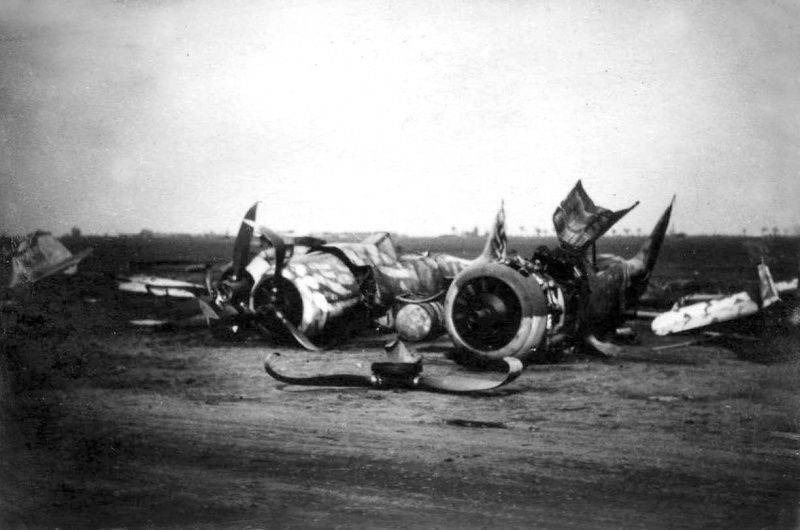
Broken German fighters Fw.190 at the airport Yutherborg near Berlin
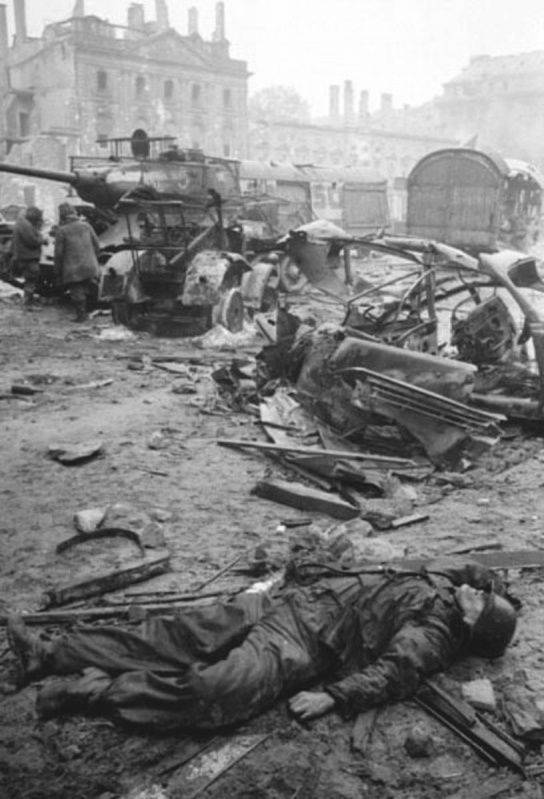
Killed German soldier and tank T-34-85 55-th Guards Tank Brigade on the streets of Berlin
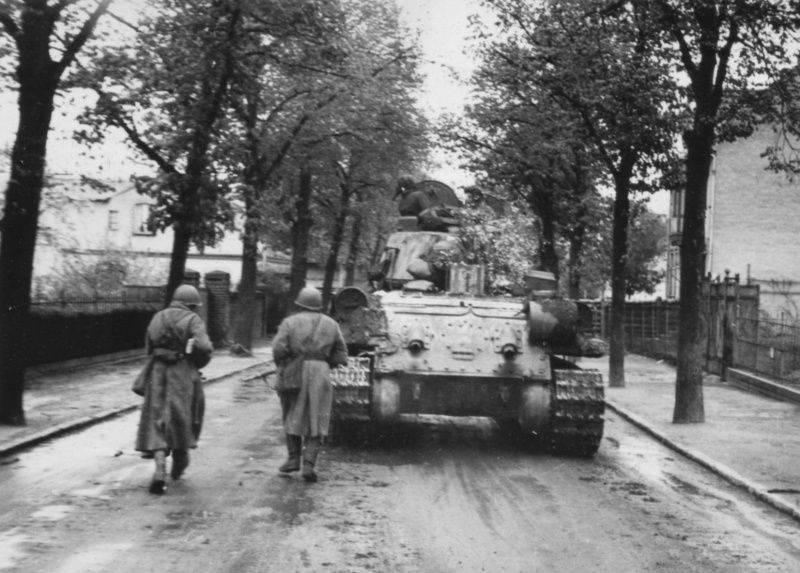
Soviet tank T-34-85, accompanied by infantry moving along the street on the outskirts of Berlin
Actions of the 1 of the Ukrainian Front
3-I and 4-I Guards tank armies Rybalko and Lelyushenko, who 18 April successfully crossed the Spree, launched an offensive on the capital of the Reich. Each tank army was supported by an assault and fighter corps. As Konev noted, “... in our case, in a whole number of cases, there were no new defensive lines in front of our troops. And those that met, were located front to the east, and our units quietly went north past them and between them, but only to the external bypass, encircling the whole of Berlin. "
On April 19, Rybalko’s guards took the important communications center of Fetschau, pogroming the rear and headquarters of the 21 German Tank Division. German troops attempted to thwart the advance of Soviet mobile units by counterattacks from the Cottbus region. However, the German attacks were successfully repulsed by the 16 self-propelled artillery brigade. By the end of the day, the advanced units of the 3 Guards Tank Army began a battle for Lübbenau. Meanwhile, 4-I Guards Tank Army Lelyushenko approached Luccau. Moving forward 50 kilometers to the northwest, the mobile units broke away from the infantry.
However, approaching Berlin, our tankers met an increasingly strong resistance of the enemy. On April 20, tank units reached the Zossensk defensive area, where the headquarters of the ground forces headquarters was located in deep underground bunkers. Here the Germans erected a whole underground city where various departments and headquarters services were located. Back in 1936, the German command decided to build a new, secure communication center, which received the code name Zeppelin (Zepellin), a secret command and control center for troops and communications. By 1939, the object was ready. The center was commissioned on 26 on August 1939, five days before the start of the Polish campaign.
The object combined an underground staff complex and the most modern telecommunication center in Western Europe of that time, codenamed “AMT500”. The telecommunication network of the center was locked on a ring backbone of a secure connection that encircled Berlin. Also in the center, there was a powerful radio center. The entire complex, which was located on two underground levels, had a total area of 4881 square. m
The secret staff complex of the German ground forces was called Maybachlager and consisted of three zones-segments. The ground part of the headquarters complex consisted of 12 concrete bunkers (on map A 1 - A 12) disguised as residential buildings. All of them were connected to a ring underground galleries, and their ground part was locked, had protection from a gas attack, independent water supply and two fortified underground levels. In this headquarters, the fate of millions was decided, plans for war with France and the USSR were developed. Interestingly, the location of the Maybach was kept secret until 1944.
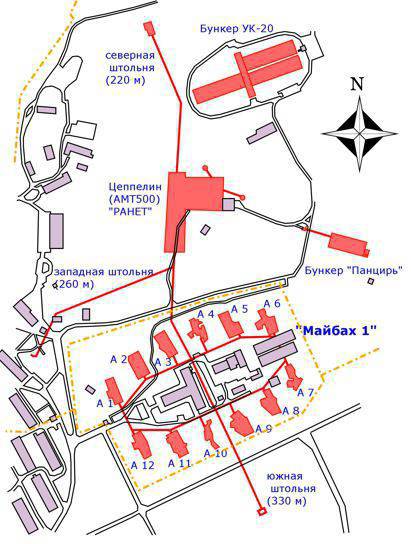
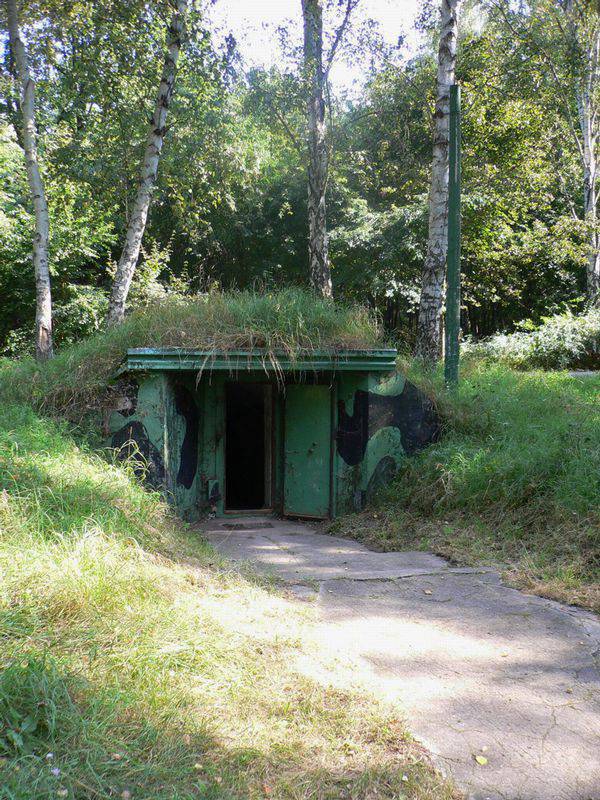
One of the entrances to the "Zeppelin"
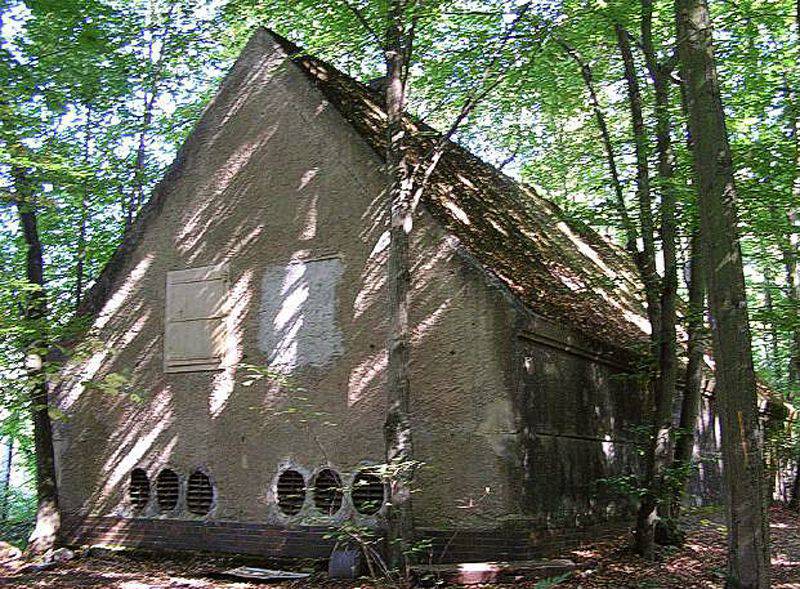
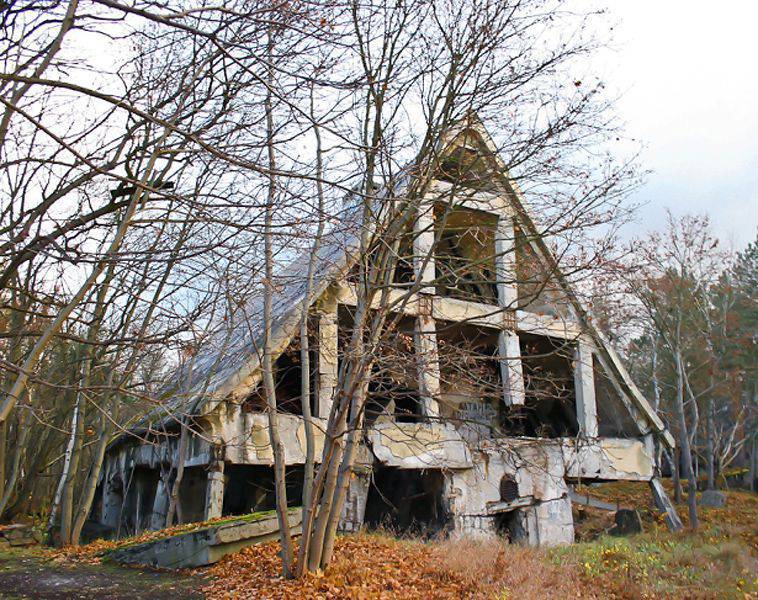
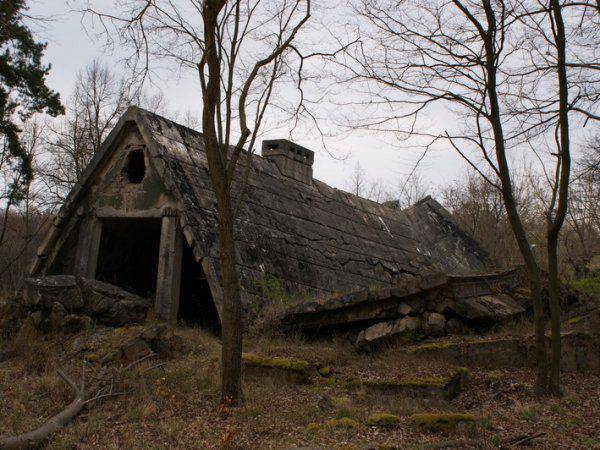
Entrance to one of the Maybach 12 concrete bunkers disguised as a residential building
Therefore, Zossen defended four defensive lines. The depth of the Zossen defensive region reached 15 kilometers. In addition, the area itself was inaccessible, contributed to the equipment of anti-tank defense. The terrain was wooded and swampy, with numerous lakes, ponds. This made it difficult to maneuver mobile connections. On roads and inter-grain defiles, heaps were built, long-term emplacements were built, tanks were buried in the ground. The settlements were prepared for all-round defense. Zossensk defensive area had its own garrison number to the infantry division.
By April 12 20, the troops of the 6-th Guards Tank Corps of the 3-th Guards Tank Army reached the city of Barut. An attempt by the forward detachments to take the city was not a success. Then 53-I and 52-I Guards Tank Brigades were sent to storm Barut: the first was to attack the city from the southeast, the second from the west, beating the enemy. After a short artillery strike, the Guardsmen attacked the enemy. The German garrison could not stand it, and by the 13 watch they took the city.
While advancing to Zossen, our troops again met strong resistance. Tankers had to consistently break through the defensive lines of the enemy, which slowed down the advance of the Soviet troops. The woodland and marshland restricted the maneuver of tank units. Only by the end of 21 in April, our troops cleared the Zossensky defensive area from the Nazis. On the night of April 22, Zossen was taken. German general staff fled to Berlin, which was located in 30 km. Underground bunkers were thrown with such haste that it was possible to flood and blow up only part of this underground structure. After the war, the territory of the headquarters of the Group of Soviet Forces in Germany (GSVG), located at that time as Wünsdorf, was located here.
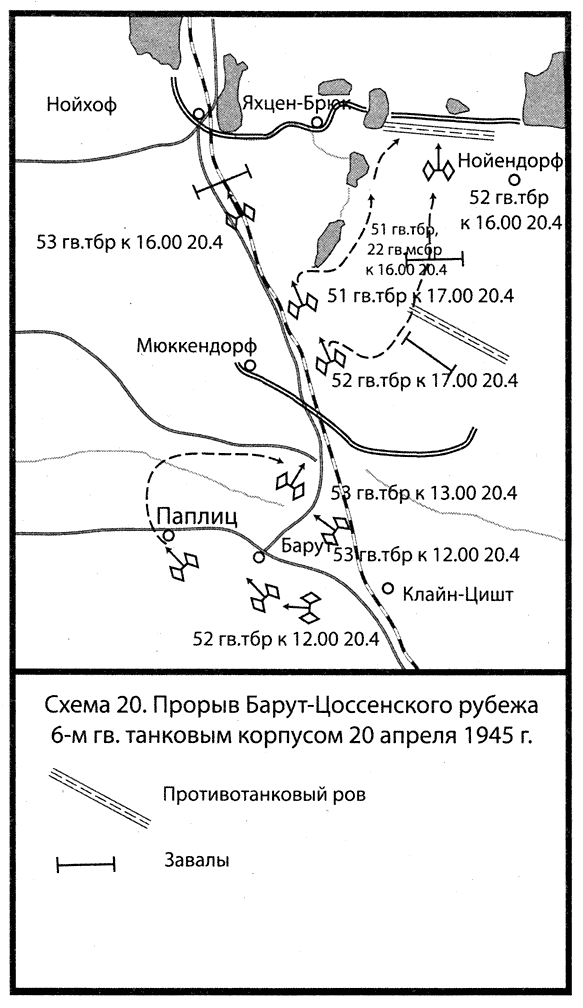
Map source: Isaev A.V. Berlin 45
Meanwhile, the 4-I Guards Army reached the line Lukenwalde - Uterbog, where stubborn fighting also took place. In general, on April 21, tankers Rybalko and Lelyushenko reached the southern section of the outer defensive bypass of Berlin.
At this time, the combined-arms armies continued their offensive to the west, fighting against the enemy's Kotbussky and Shpremberg groups. 13-I army Pukhov ensured the entry into the breakthrough of the tank armies, deeply wedged in the defensive orders of the enemy in the center of the breakthrough. However, strong enemy groups in the Cottbus and Spremberg areas hung over its flanks.
3-I Guards Army Gordov moved to the west and north-west and led heavy fighting with German troops in the Cottbus region. German troops, relying on strong points on the outskirts of the city, put up fierce resistance. Therefore, our troops moved slowly. Only by the end of April 19 did Soviet troops reach the eastern outskirts of Cottbus and part of the forces bypassed the city from the southeast. However, the entire right flank of the shock group of the 1 of the Ukrainian Front from Cottbus to Zossen remained open. This made it possible for the enemy's Frankfurt-Guben grouping (units of the German 9 Army, cut off in the area south-east of Berlin) to flee to Berlin or to the west. Tank armies were aimed at Berlin, and in order for them to close this gap, they had to be withdrawn back. Therefore, Konev decided to enter into battle the second echelon of the front — Lucinschi’s 28 Army, which had just reached the battle area from the rear. Part of its forces was aimed at strengthening the 3-th Guards Tank Army, the main forces were sent to complete the encirclement of the German Frankfurt-Guben enemy grouping.
Persistent battles were fought on the left wing of the main strike force in the Spremberg area. 5-I Guard Army Zhadova fought for the expansion of the bridgehead on the river Spree. Its 19 units of April, along with the troops of the 13 Army, blocked the Spremberg area. Here, the Germans led the 344 Infantry Division to the battle, which was transferred here from the right flank of the 17 Army and, using the remnants of the units that had bypassed the Neisen line, organized a strong defense. The city was a strong knot of defense. To defeat this "toughie", the Soviet command attracted here a large number of artillery - 14 artillery brigades (1104 guns and mortars, 143 Guards mortars). At the same time, significant aviation forces were attracted here. On the night of April 20, bomber Po-2 208 of the night bomber aviation division attacked the enemy’s defense site. In 11 hours after the 30-minute artillery preparation, the troops of the 33-th Guards Corps of the 5-th Guards Army went on the assault on Spremberg. The Germans desperately resisted, but did not withstand the onslaught of the Soviet soldiers. April 20 Spremberg fell. After the seizure of this powerful node of resistance, the troops of the 5 Guards Army sped up.
Map source: Isaev A.V. Berlin 45
Significant success in these days has reached the 13-I army of Pukhov. Soviet troops reached Finsterwalde, advancing 50 km west of Spree. 5-I Guard Army Zhadova, having passed 30 kilometers west of Spremberg, reached the line west of Senftenberg - Hoyersverd. 25 April at 13 hour. 30 min. in the 5 Guards Army Band, in the Strela area, on the Elbe River, units of the 58 Guards Division met with the 1 American Army reconnaissance group. On the same day, in the Torgau area on the Elbe River, the forward battalion of the same 58 Guards Division met with another American reconnaissance group.
The offensive of the left-flank shock grouping of the front in the Dresden sector developed slowly. The Germans stubbornly resisted and repeatedly went on counterattacks. In order to speed up the 52 Army’s advance, the front command narrowed its line of responsibility, which made it possible to strengthen the strike fist. Next to the 52 Army, the 31 Army formations were deployed. However, the German command also transferred new forces to the Dresden sector, and the Goerlitz grouping efforts. Therefore, the battles in the Dresden sector remained fierce. German armored units launched a series of heavy blows on the left flank of the 2 Army of the Polish Army. However, all attempts of the German troops to crush the left wing of the 1 of the Ukrainian Front failed. A major role in repelling the attacks of the enemy was played by our aviation, which, in spite of the often unfavorable weather, delivered strikes against German battle formations. Only in the afternoon of April 21, when the weather conditions improved, the assault aircraft made 265 sorties, attacking German armored vehicles in the Görlitz region.
Part of the forces of the left wing of the 1 of the Ukrainian Front continued to develop the offensive in the south-western direction. The 1 th Guards Corps attacked Ortrand, leading battles northwest of Kamyanets. The 7 Guards Mechanized Corps, with the support of the 52 Army infantry, took the city of Bautzen. Polish troops, overcoming the resistance of the enemy, went to the area of the city of Burkau. During the three-day brutal battles, the left-flank shock grouping of the front reflected strong enemy counterattacks and part of the forces advanced to the south-west (Dresden direction) by 20 kilometers, and to the west - to 45 kilometers.
23 on April in the Dresden direction of the enemy's gorlitsa group, received reinforcements and again launched a counteroffensive in the direction of Spremberg. The Germans formed two strike groups in the area of Bautzen and Weissenberg. The German infantry and tanks, with the support of aviation, creating an advantage in the direction of strikes, were able to break through the front of the 52 Army, and went into the rear of the 2 Polish Army. A fierce battle went on for several days. The Germans were able to advance in the direction of Spremberg on 33 km, but were stopped. The command of the front redeployed part of the forces of the 5-th Guards Army, the 2-th Army of the Polish Army to the dangerous area, intensified their actions on the 2-I Air Army.
On the night of April 22, units of the 3 Guards Tank Army Rybalko overcame the Notte Canal and, on the Mittenwalde, Zossen section, broke through the outer defensive bypass of Berlin. Having entered the Teltow Canal, Soviet tankers, supported by infantry of the 28 Army, front artillery and aviation, broke through to the southern edge of the capital of the Third Reich. This water line was a serious obstacle: the width of the 40-50 meters, high concrete banks, the northern coast was well equipped - trenches, long-term fire installations, tanks dug in and ground assault guns. Over the canal there passed a chain of strong stone houses, each of which could be a small fortress. Break through the channel did not work. Therefore, the Soviet command decided to conduct a thorough training, to bring artillery. 23 April, Rybalko’s army was preparing to storm the enemy’s position.
The advancing left units of the 4 Guards Tank Army, Lelyushenko, captured Uterbog, Lukkenwalde and quickly moved to Potsdam and Brandenburg. In the area of Luckenwald on April 22, a prisoner of war camp was liberated, where more than 15 thousands of French, British, Americans, Italians, Serbs, Norwegians and others received freedom. Among the prisoners were more than 3 thousands of Russians. In the 12 hours of the day of April 25 west of Berlin, the advance units of the XXUMX Guards Tank Army Lelyushenko met with units of the 4 Army Perkhorovich of the 47 Belorussian Front. The ring of Berlin's entourage has closed.
22 April 3-I Guards Army Gordova completed the defeat of the enemy's Cottbus grouping. An important knot of enemy defense Cottbus fell. Soviet guardsmen began to move to the north, with the aim of defeating the surrounded forces of the 9 Army and preventing its breakthrough to Berlin or westward to the rear of the German forces attacking the capital.
Thus, the 1 Belarussian and 1 Ukrainian Fronts completed the breakthrough of the Oder and Neisen defense lines and successfully maneuvered around the garrison of Berlin and isolated from the capital most of the 9 Army in the forests south-east of the city. The left-flank armies of the 1 of the Byelorussian Front, breaking through the outer defensive line of the Berlin region, broke into the suburbs of the German capital and engaged in a battle for the city. The tank armies of the 1 of the Ukrainian Front made a brilliant jerk to the north-west, broke through the borders of the Zossensky defensive area, overcame the southern portion of the defensive bypass, and started a battle for the southern part of Berlin. Part of the forces attacked Potsdam and Brandenburg, covering Berlin from the southwest.
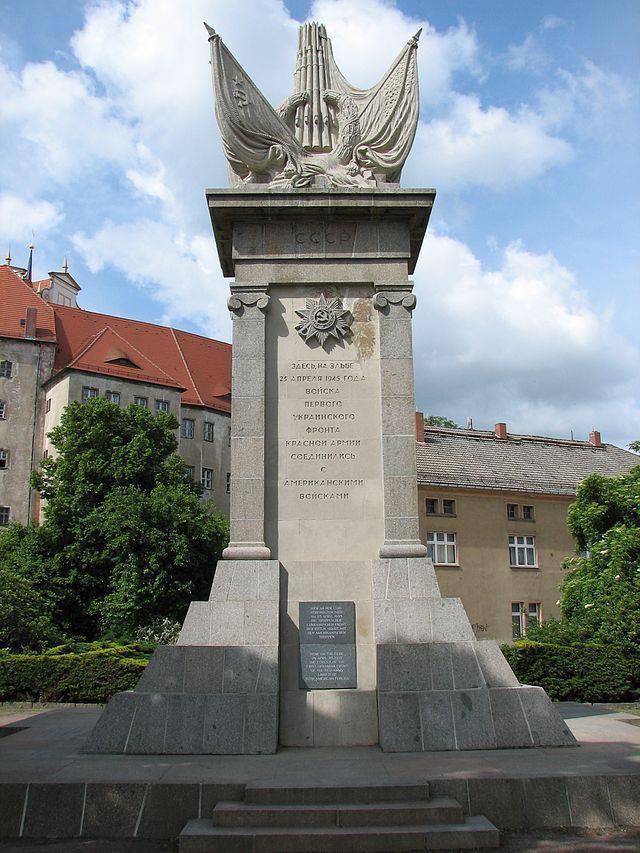
Memorial sign installed at the meeting place on the Elbe
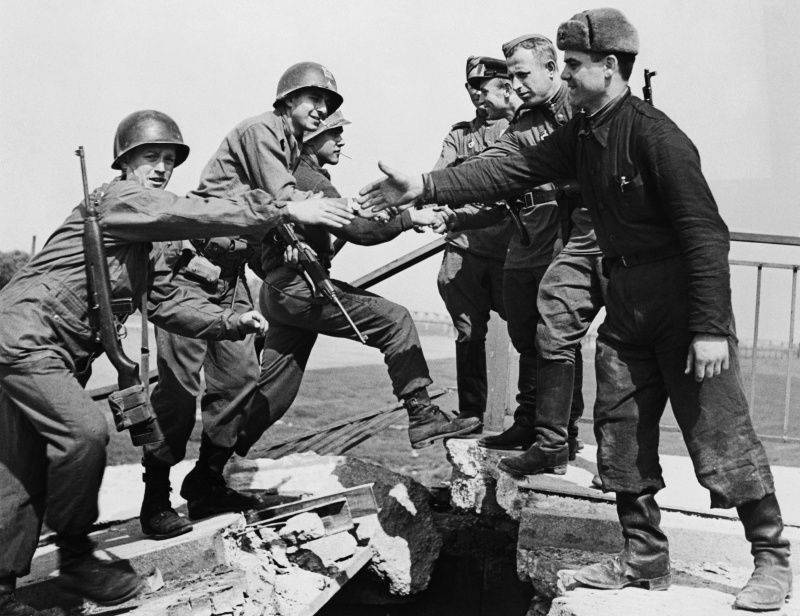
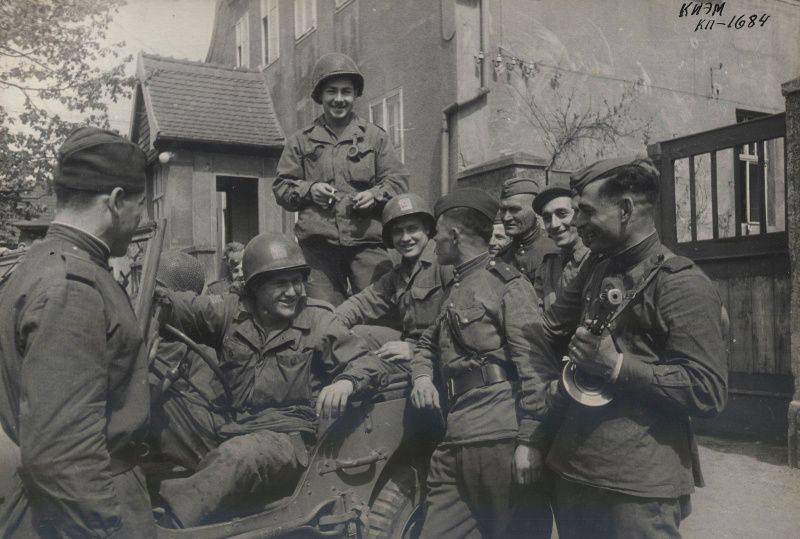
Meeting of Soviet and American soldiers on the Elbe
The actions of the German command
The German headquarters was making desperate efforts to gain time, halt the Soviet offensive. 22 April Adolf Hitler made the final decision to stay in the capital and personally lead the fight for Berlin, although he was offered to flee south to the location of Army Group Center. Opportunities for this were still. In the imperial office about 15 hour. a large operational meeting was convened where Hitler admitted for the first time that the war was lost. At the same time, the Führer went into hysterics and declared that the infidelity and betrayal of the generals led to defeat. Hitler ordered Wilhelm Keitel, Alfred Jodl and Martin Bormann to fly south to continue the resistance from there, even if Berlin fell. But those showing devotion to the Fuhrer refused.
As a final desperate measure, the supreme German command decided to open the Western Front and abandon the troops fighting against the Anglo-American armies in the battle for Berlin. For the decisive battle for Berlin, they planned to use the Steiner army group, the 9 army, and the newly created 12 army, General Wenck. Steiner's army group was supposed to strike from north to south, from the Eberswald area. Wenk's 12 Army from the area south-west of Berlin, advancing to the east to join up with the 9 Army making its way to the west, then unite efforts, launch a counter-offensive and free Berlin. At the same time, the 4-I tank army was to launch a counterattack on the flank of the 1-th Ukrainian Front.
Emergency measures were taken to strengthen the defense of Berlin. In the capital, continued the formation of units of the Volkssturm. A total of about 200 militia battalions were formed. 22 April released prisoners from civilian and military prisons who were used to defend the city. The Berlin garrison numbered about 80 thousand soldiers and officers who managed to break into the city units and divisions and 32 thousand police officers. A favorable factor for the Red Army was that most of the 9 Army was surrounded southeast of Berlin and could not take part in the battle for the city. The storming of Berlin could go longer and with great losses.
Thus, the Nazis were not going to surrender. The Fuhrer announced that he would remain in Berlin, and the city would be defended to the last man. Goebbels urged soldiers and townspeople to persevere, insisting that the battle for Berlin would bring victory to Germany.
23 On April, Keitel visited the headquarters of the 12 Army to prepare for a new task. Keitel discussed with Wenke a counteroffensive plan for Berlin in the direction of Potsdam with a view to connecting with the 9 Army. Then Keitel and Jodl again went to Hitler in the imperial office. German commanders last talked with Hitler. After the meeting in the imperial office, Field Marshal Keitel again went to the headquarters of the 12 Army to influence the course of the operation.
Meanwhile, the position of Berlin was deteriorating every day. With the loss of urban suburbs, the Germans lost a significant part of their warehouses, especially with food. By 22 April, strict consumption standards were established: 800 grams of bread and potatoes, 150 grams of meat and 75 grams of fat per week per person. Since 21, April, almost all enterprises stopped their work, as the supply of electricity and gas was cut off and coal supplies ran out. The subway stopped, trams, trolleybuses did not go, water supply and sewage systems did not work. The city was in a panic, many fled, especially the party functionaries, their families. Among those who left Berlin were top executives like Goering and Himmler. The townspeople were unhappy and began to realize that the war was lost. However, propaganda, the habit of discipline, loyalty to the Führer of the party and state apparatus and the army forced everyone to fight to the end.
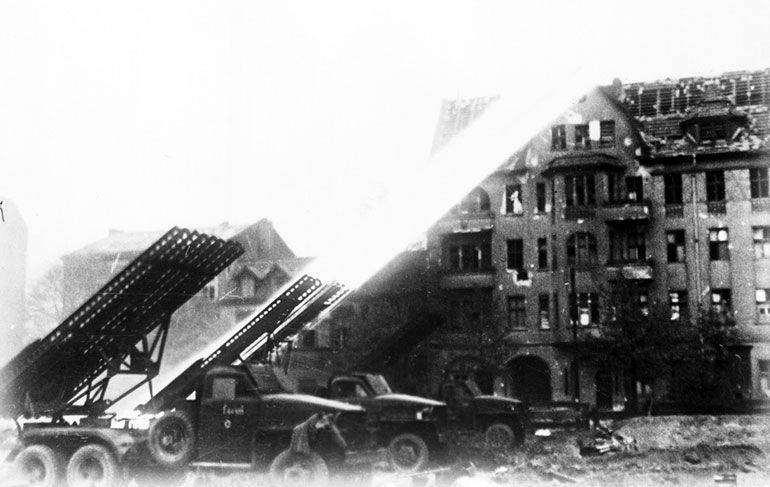
To be continued ...
- Alexander Samsonov
- Part 1. The epic of the battle for Berlin became the crown of the victorious conclusion of the Great Patriotic War as a heroic feat of the Soviet people in the name of the salvation of all mankind
Part 2. The agony of the Third Reich
Part 3. How the Wehrmacht was preparing for the decisive battle for Berlin
Part 4. German defense in the Berlin direction
Part 5. How the Red Army was preparing for the battle for Berlin
Part 6. Battle for Seelow Heights
Part 7. Breakthrough Oder
Part 8. The breakthrough of the Neysen border by the troops of the 1 of the Ukrainian Front
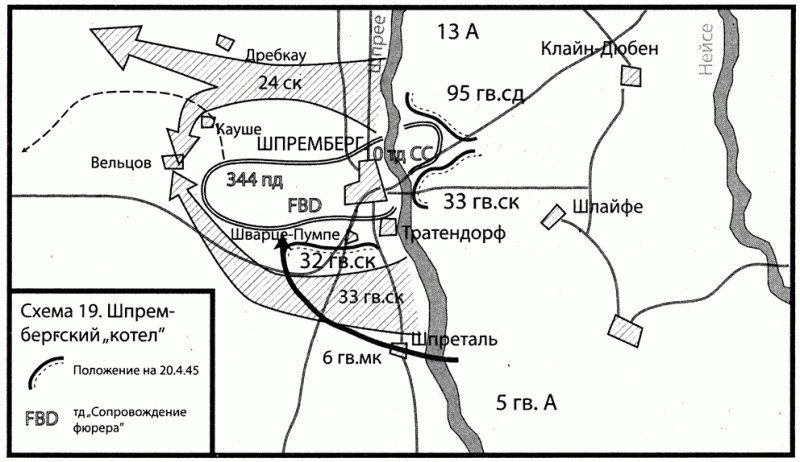
Information